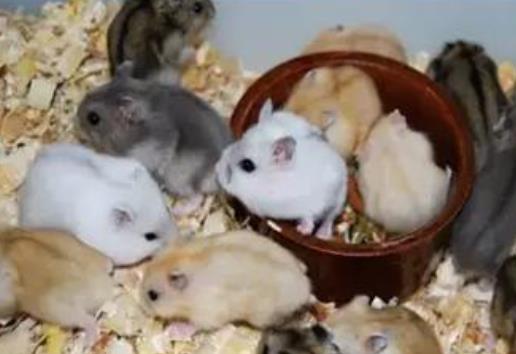Caring for dwarf hamsters (such as Campbell’s Dwarf Hamsters, Purple Campbell’s, Winter White Dwarf Hamsters, and Pudding Hamsters) requires comprehensive consideration of multiple aspects, including living environment, diet management, daily care, health monitoring, and interaction & training. Below is a detailed guide to help you care for dwarf hamsters scientifically:

I. Creating a Suitable Living Environment
Cage Selection
Size: Dwarf hamsters are highly active. The cage should be at least 40cm long (a 60cm basic cage is better), and the height should accommodate climbing needs (e.g., with a ladder or platform added).
Material: Prioritize wire cages (for good ventilation) with a plastic or glass tray at the bottom (to prevent bedding from spilling). Avoid fully glass cages (prone to stuffiness and lack of climbing space).
Cage Layout
Exercise Wheel: Choose a wheel with a diameter of ≥17cm (specifically for dwarf hamsters) to prevent spinal deformation; a silent wheel reduces noise disturbance.
Hideout: Provide a ceramic or wooden hut for the hamster to rest and escape stress.
Tunnels/Pipes: PVC pipes or wooden tunnels can simulate a natural environment and increase exploration fun.
Bedding
Summer: Use paper cotton (excellent for odor absorption) or dust-free wood shavings (with a thickness of over 5cm). Avoid cat litter (risk of accidental ingestion).
Winter: Add (defatted cotton) or a warm nest. When the temperature drops below 15°C, take warming measures (e.g., using a heating pad outside the cage).
Environmental Control
Temperature: Maintain 20–28°C; avoid direct sunlight or direct air conditioning drafts.
Humidity: Keep humidity at 40%–60%. Damp environments easily breed bacteria—use a dehumidifying box or bamboo charcoal bag to adjust.
Cleaning: Replace 1/2 of the bedding weekly and thoroughly clean the cage monthly (use pet-specific disinfectant to avoid residue).
II. Scientific Diet Management
Staple Food Selection
Specialized Hamster Food: Mainly composed of grains (e.g., oats, millet), with a small amount of seeds (sunflower seeds, flaxseeds) and dehydrated vegetables (carrots, broccoli). Avoid cheap foods containing sugar or additives.
Recommended Brands: Bunny Expert Series, VK Dwarf Hamster Food, Oxbow Timothy Bites (high in fiber, low in fat).
Supplementary Food
Protein: Offer cooked egg whites, mealworms (head-removed), or unsalted dried shrimp 2–3 times a week (1–2 pieces each time).
Fruits & Vegetables: Provide a small amount of fresh fruits and vegetables (e.g., apples, broccoli, carrots) daily. Wash and dry them before feeding to avoid diarrhea from excess moisture.
Forbidden Foods: Toxic foods like onions, chocolate, almonds, and raw potatoes; high-sugar fruits (e.g., grapes, mangoes) should be given in tiny amounts.
Water Management
Use a vacuum-pressure water dispenser (leak-proof and silent). Change the water and clean the spout daily to prevent water contamination.
In summer, add a small amount of electrolyte powder (e.g., Vetark) to supplement minerals.
III. Daily Care & Health Monitoring
Fur Care
Dwarf hamsters do not need frequent baths. Provide bath sand (e.g., volcanic ash bath sand) for them to clean themselves. Avoid water baths, which can cause colds or skin problems.
Check the fur weekly to ensure it is fluffy and smooth. If hair loss, dandruff, or redness occurs, it may indicate a skin disease or parasite infestation—seek veterinary care promptly.
Teeth Check
Hamsters’ teeth grow continuously. Provide a chew stone or apple branch for them to gnaw on.
Check the tooth length monthly. If teeth are too long (e.g., affecting eating), trim them with pet-specific nail clippers or consult a vet.
Health Indicators
Normal Signs: Bright eyes without discharge, moist nose, clean anus, and agile movement.
Abnormal Signs:
Decreased appetite or sudden weight loss: May indicate illness (e.g., wet tail, cold).
Frequent scratching or messy fur: May signal a skin disease or parasites.
Rapid breathing or hunchback posture: May indicate pain or internal issues—seek immediate veterinary help.
IV. Interaction & Training Tips
Interaction Timing
Dwarf hamsters are nocturnal. The best time to interact is in the evening or at night (their active peak).
For initial interactions, reach into the cage slowly—avoid sudden grabbing. Build trust by offering food from your hand first.
Training Methods
Hand-Taming: Use snacks to guide the hamster to climb onto your palm, gradually extending the time it stays. If the hamster struggles, put it back in the cage immediately—avoid forced interaction, which can cause stress.
Command Training: Train the hamster to respond to calls by repeating commands (e.g., “Come back”) and rewarding with snacks.
Toy Interaction: Use a laser pointer, crumpled paper, or tunnel toys to stimulate the hamster’s curiosity and increase exercise.
Notes
Avoid housing multiple hamsters together (especially same-sex ones)—fights easily occur, leading to injuries.
Wash your hands after interacting to prevent cross-bacterial infection.
V. Handling Special Situations
Escape Response
Close doors and windows, and use snacks (e.g., sunflower seeds) to guide the hamster back near the cage.
Place cardboard boxes or tunnels in corners to increase hiding spots, making it easier to catch the hamster.
Stress Reactions
When in a new environment or frightened, hamsters may play dead (stiff limbs, weak breathing). Keep the area quiet, cover the cage with a towel to soothe them—recovery usually takes 10–30 minutes.
Avoid frequent cage layout changes or loud noises to reduce stress triggers.
Winter Warming
When the temperature drops below 15°C, wrap the cage in a blanket or use hand warmers (placed outside the cage to avoid burns).
Provide ample bedding and defatted cotton for the hamster to build a warm nest.
VI. Common Mistakes to Avoid
Housing Together: Dwarf hamsters have strong territorial instincts—cohabitation leads to fights; they must be kept in separate cages.
Feeding Human Snacks: High-sugar, high-salt foods (e.g., cookies, chips) cause obesity or digestive problems.
Ignoring the Exercise Wheel: Lack of exercise leads to obesity and heart disease—ensure the wheel is the right size and used daily.
Frequent Baths: Water baths or using human body wash damage the hamster’s skin oil layer, causing dryness or infection.
With scientific care, dwarf hamsters can live with you for 2–3 years. Regularly observe their behavior and health status, and adjust your care methods promptly to ensure your hamster lives a comfortable and healthy life.
